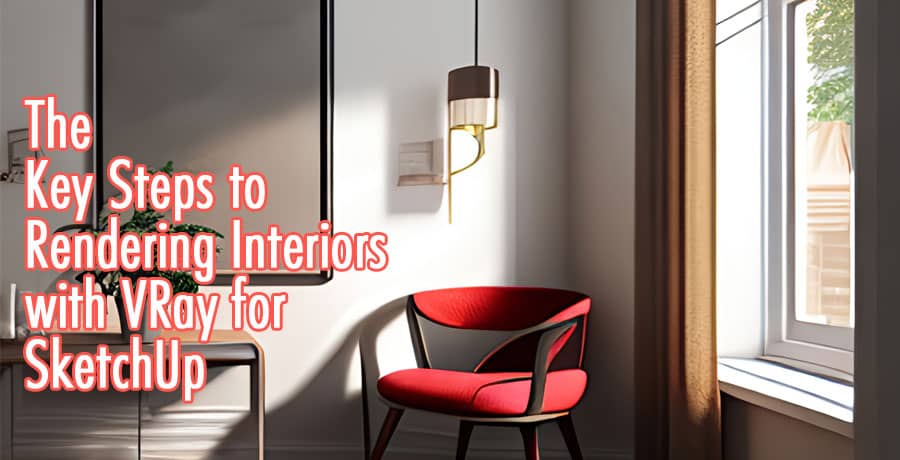Introduction
Are you looking to enhance the visual appeal of your interior designs? V-Ray for SketchUp is a powerful rendering tool that can bring your 3D models to life.
Understanding V-Ray for SketchUp
Before diving into the rendering process, let’s understand what V-Ray is and why it is the preferred choice for SketchUp users. V-Ray is a rendering engine that works as an extension for SketchUp, a popular 3D modeling software. It provides advanced lighting and rendering capabilities, allowing designers to create photorealistic visualizations.
Setting up V-Ray for SketchUp
To get started with V-Ray for SketchUp, you need to install the V-Ray extension and configure the settings. The installation process is straightforward and can be done by following the provided instructions. Once installed, you can access V-Ray through the SketchUp interface.
Preparing the scene for rendering
Before rendering, it’s essential to optimize your SketchUp model for better performance. This involves cleaning up the geometry, ensuring proper scale, and removing unnecessary elements. Additionally, applying materials and textures to your model and setting up appropriate lighting will greatly enhance the realism of your renders.
Adjusting V-Ray render settings
V-Ray offers various render settings that can be adjusted to achieve the desired output. Quality settings control the level of detail and smoothness in the render, while image size and resolution determine the final output dimensions. Render elements allow you to separate different components of the scene, such as reflections or shadows, for post-processing flexibility.
Fine-tuning the render
To further enhance the visual quality of your render, V-Ray provides options for global illumination, reflections, and refractions. Global illumination accurately simulates the way light bounces around the scene, resulting in realistic lighting effects. Reflections and refractions add depth and complexity to materials, making them look more natural. Depth of field can also be adjusted to control the focus and blur in the render.
Rendering the scene
Once all the settings are adjusted, it’s time to render your scene. V-Ray offers various render options and parameters that can be customized to fit your requirements. You can choose between progressive rendering, which continuously refines the image quality, or bucket rendering, which divides the image into smaller regions for faster processing.
Post-processing the rendered image
After rendering, you can further enhance the image by post-processing it in image editing software. Adjusting the brightness, contrast, and color balance can help fine-tune the overall look. Additionally, you can experiment with various effects and filters to add artistic touches and create a unique visual style.
Troubleshooting common issues
During the rendering process, you might encounter some common issues. Render artifacts such as noise or splotches can occur due to incorrect settings or insufficient sampling. Long render times can be caused by complex scenes or high-quality settings. Managing memory usage is crucial to prevent crashes or slowdowns during rendering. Understanding these issues and applying appropriate solutions will help you overcome potential hurdles.
Conclusion
Rendering interiors with V-Ray for SketchUp opens up a world of possibilities for designers and architects. By following the key steps outlined in this article, you can create stunning visualizations that showcase your design ideas effectively. V-Ray’s powerful rendering capabilities combined with SketchUp’s intuitive modeling interface make it a valuable tool for professionals in the industry.
FAQs
Can VRay for SketchUp be used for exterior rendering as well?
Yes, V-Ray for SketchUp is suitable for both interior and exterior rendering. It offers a wide range of settings and features that can be adapted to different scenes and lighting conditions.
Is V-Ray difficult to learn for beginners?
While V-Ray has a learning curve, there are plenty of tutorials and resources available online to help beginners get started. With practice and experimentation, you can quickly grasp the essential concepts and techniques.
Can I use my own materials and textures with V-Ray for SketchUp?
Yes, VRay allows you to use custom materials and textures. You can import your own textures or create materials within the VRay material editor.
What is the advantage of using global illumination in rendering?
Global illumination accurately simulates the way light interacts with surfaces, resulting in realistic lighting effects such as soft shadows, color bleeding, and indirect lighting. It adds a sense of depth and realism to the rendered scene.
Are there any hardware requirements for using V-Ray for SketchUp?
V-Ray for SketchUp can be resource-intensive, especially for complex scenes and high-quality renders. It is recommended to have a powerful computer with a capable graphics card and sufficient RAM for optimal performance.


